The Rise of Raw Pet Food: What’s Behind the Trend?
In recent years, the pet food industry has seen a significant shift towards raw feeding, with more and more pet owners swapping traditional kibble for fresh, raw ingredients. Known as the “raw food diet,” this approach mimics what animals would eat in the wild, offering pets a diet made up of raw meat, bones, vegetables, and sometimes organs. But what’s driving this growing trend, and is it really better for our pets? Let’s dive into the rise of raw pet food and explore its potential benefits and drawbacks.
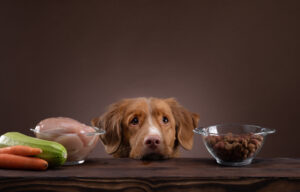
What is the Raw Food Diet for Pets?
The raw food diet, sometimes referred to as BARF (Biologically Appropriate Raw Food or Bones and Raw Food), is designed to replicate the natural diet of dogs and cats before the advent of commercial pet foods. This means feeding them a diet primarily made up of raw, unprocessed meat, bones, and offal, sometimes complemented with vegetables and fruits.
For dogs, this often includes raw muscle meat, whole or ground bones, organ meats like liver, and eggs. Some diets may incorporate fruits and vegetables like spinach, carrots, and apples. Cats, being obligate carnivores, typically require a higher meat-to-vegetable ratio, with an emphasis on muscle meats and organs.
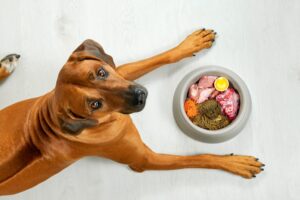
Why Has Raw Feeding Become So Popular?
The raw pet food trend has gained momentum for several reasons, primarily driven by pet owners’ desire to provide a more natural, wholesome diet for their animals. Here are some of the key reasons behind its growing popularity:
- Perceived Health Benefits: Many raw feeders believe that feeding pets a diet closer to what they would naturally eat can lead to improved health. Supporters of raw diets claim that it promotes shinier coats, healthier skin, cleaner teeth, increased energy levels, and even better digestion. Some pet owners have turned to raw feeding after noticing their pets suffer from allergies or digestive issues on traditional kibble.
- Quality Control: One major appeal of raw feeding is the control it gives owners over what goes into their pets’ meals. With increasing concerns over the quality of some commercial pet foods, including additives, preservatives, and low-quality ingredients, raw feeding offers transparency. Owners can ensure their pets are getting high-quality, fresh ingredients.
- A Trend Towards Personalised Nutrition: Just as people are becoming more mindful of their own diets, they are increasingly applying the same principles to their pets. Personalised nutrition is on the rise, and raw feeding offers a more tailored approach that can be adjusted to meet individual pets’ needs.

Potential Benefits of Raw Feeding
Advocates of raw feeding point to several potential benefits that might explain its growing popularity:
- Improved Coat and Skin Health: Many pet owners report seeing improvements in their pets’ coats and skin after switching to a raw diet. Raw meat contains higher levels of natural oils and fats, which can contribute to a shinier coat and reduce skin irritation.
- Cleaner Teeth and Better Oral Health: Chewing on raw bones is believed to help reduce plaque and tartar build-up, leading to healthier gums and cleaner teeth. This natural dental care may reduce the need for professional cleanings and help prevent periodontal disease.
- Higher Energy Levels: Some raw feeders have noted that their pets seem more energetic and lively after making the switch. This could be due to the absence of fillers found in some commercial pet foods, which may leave pets feeling sluggish.
- Smaller, Firmer Stools: Raw feeding is thought to result in smaller, less odorous stools, as raw diets are more digestible, with fewer fillers that create excess waste.
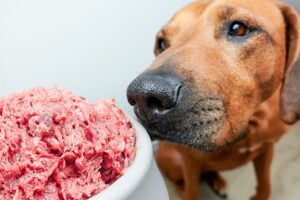
Concerns and Controversies
Despite the many perceived benefits, raw feeding is not without its controversies and potential drawbacks. Veterinarians and pet nutritionists often raise concerns about the safety and nutritional balance of raw diets.
- Nutritional Imbalance: A major concern with raw feeding is the potential for unbalanced meals. Without careful planning, pets may miss out on essential nutrients, such as calcium and certain vitamins, which are critical for their health. This is particularly risky for growing puppies and kittens, who have very specific dietary needs. While some commercial raw pet foods offer balanced formulations, homemade diets require careful research and planning.
- Risk of Bacterial Contamination: Raw meat can carry bacteria like Salmonella and E. coli, which pose a risk to both pets and their owners. While pets have stronger stomach acid that may protect them from some bacteria, there’s still a risk of infection. Handling raw meat also increases the chance of spreading bacteria in the home, which is a concern for households with young children or immunocompromised individuals.
- Bone-Related Injuries: Raw bones, while helpful for oral health, can also be a hazard. Bones that are too hard can cause dental fractures, while smaller bones can pose a choking risk or lead to internal injuries if they splinter.
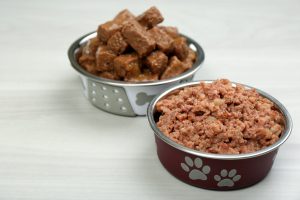
Is Raw Feeding Right for Your Pet?
Deciding whether to switch your pet to a raw food diet is a personal choice and should involve careful consideration of your pet’s needs, lifestyle, and any health conditions they may have. While many pets thrive on a raw diet, it’s not necessarily the best option for every animal.
If you’re considering raw feeding, it’s essential to consult with a veterinarian or pet nutritionist to ensure your pet’s diet is nutritionally balanced. There are also commercial raw pet food brands available that offer complete and balanced options, reducing the risk of nutrient deficiencies.
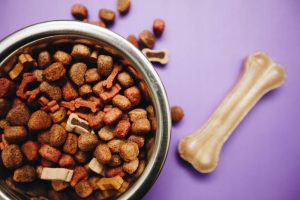
A Growing Trend with Room for Caution
The rise of raw pet food is part of a broader trend towards more natural, health-conscious pet care. While many owners report improvements in their pets’ health, raw feeding comes with its own set of challenges, particularly in terms of safety and nutritional balance.
If you choose to explore raw feeding, it’s essential to do your research and ensure you’re providing your pet with a balanced, safe diet. Whether raw or cooked, the most important thing is to ensure your pet is getting the nutrients they need to live a long, happy, and healthy life.
Read More:
Read full article Share on X